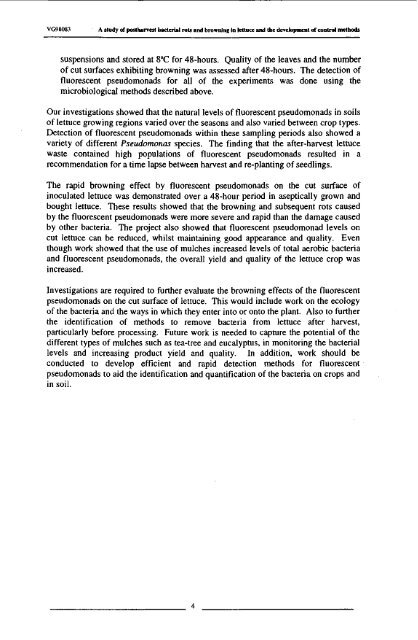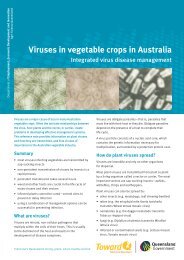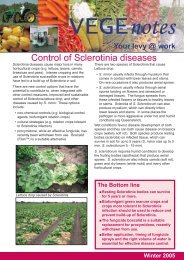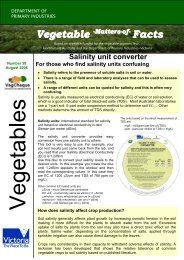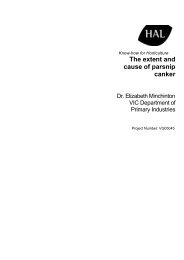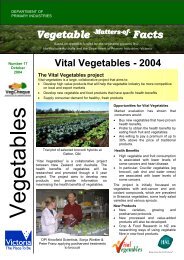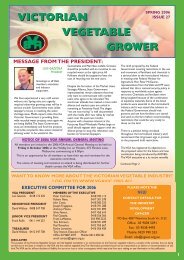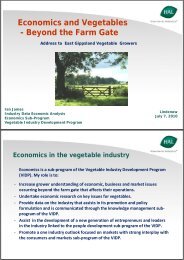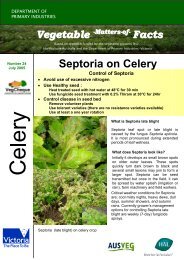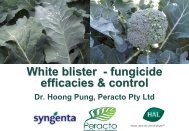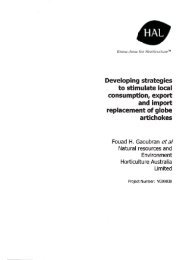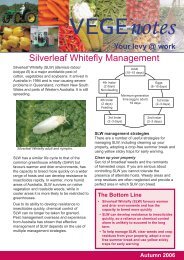Postharvest bacterial rots and browning in lettuce - Vegetable ...
Postharvest bacterial rots and browning in lettuce - Vegetable ...
Postharvest bacterial rots and browning in lettuce - Vegetable ...
You also want an ePaper? Increase the reach of your titles
YUMPU automatically turns print PDFs into web optimized ePapers that Google loves.
VG98083A study of postharvest <strong>bacterial</strong> <strong>rots</strong> <strong>and</strong> <strong>brown<strong>in</strong>g</strong> <strong>in</strong> <strong>lettuce</strong> <strong>and</strong> the development of control methodssuspensions <strong>and</strong> stored at 8°C for 48-hours. Quality of the leaves <strong>and</strong> the numberof cut surfaces exhibit<strong>in</strong>g <strong>brown<strong>in</strong>g</strong> was assessed after 48-hours. The detection offluorescent pseudomonads for all of the experiments was done us<strong>in</strong>g themicrobiological methods described above.Our <strong>in</strong>vestigations showed that the natural levels of fluorescent pseudomonads <strong>in</strong> soilsof <strong>lettuce</strong> grow<strong>in</strong>g regions varied over the seasons <strong>and</strong> also varied between crop types.Detection of fluorescent pseudomonads with<strong>in</strong> these sampl<strong>in</strong>g periods also showed avariety of different Pseudomonas species. The f<strong>in</strong>d<strong>in</strong>g that the after-harvest <strong>lettuce</strong>waste conta<strong>in</strong>ed high populations of fluorescent pseudomonads resulted <strong>in</strong> arecommendation for a time lapse between harvest <strong>and</strong> re-plant<strong>in</strong>g of seedl<strong>in</strong>gs.The rapid <strong>brown<strong>in</strong>g</strong> effect by fluorescent pseudomonads on the cut surface of<strong>in</strong>oculated <strong>lettuce</strong> was demonstrated over a 48-hour period <strong>in</strong> aseptically grown <strong>and</strong>bought <strong>lettuce</strong>. These results showed that the <strong>brown<strong>in</strong>g</strong> <strong>and</strong> subsequent <strong>rots</strong> causedby the fluorescent pseudomonads were more severe <strong>and</strong> rapid than the damage causedby other bacteria. The project also showed that fluorescent pseudomonad levels oncut <strong>lettuce</strong> can be reduced, whilst ma<strong>in</strong>ta<strong>in</strong><strong>in</strong>g good appearance <strong>and</strong> quality. Eventhough work showed that the use of mulches <strong>in</strong>creased levels of total aerobic bacteria<strong>and</strong> fluorescent pseudomonads, the overall yield <strong>and</strong> quality of the <strong>lettuce</strong> crop was<strong>in</strong>creased.Investigations are required to further evaluate the <strong>brown<strong>in</strong>g</strong> effects of the fluorescentpseudomonads on the cut surface of <strong>lettuce</strong>. This would <strong>in</strong>clude work on the ecologyof the bacteria <strong>and</strong> the ways <strong>in</strong> which they enter <strong>in</strong>to or onto the plant. Also to furtherthe identification of methods to remove bacteria from <strong>lettuce</strong> after harvest,particularly before process<strong>in</strong>g. Future work is needed to capture the potential of thedifferent types of mulches such as tea-tree <strong>and</strong> eucalyptus, <strong>in</strong> monitor<strong>in</strong>g the <strong>bacterial</strong>levels <strong>and</strong> <strong>in</strong>creas<strong>in</strong>g product yield <strong>and</strong> quality. In addition, work should beconducted to develop efficient <strong>and</strong> rapid detection methods for fluorescentpseudomonads to aid the identification <strong>and</strong> quantification of the bacteria on crops <strong>and</strong><strong>in</strong> soil.4


